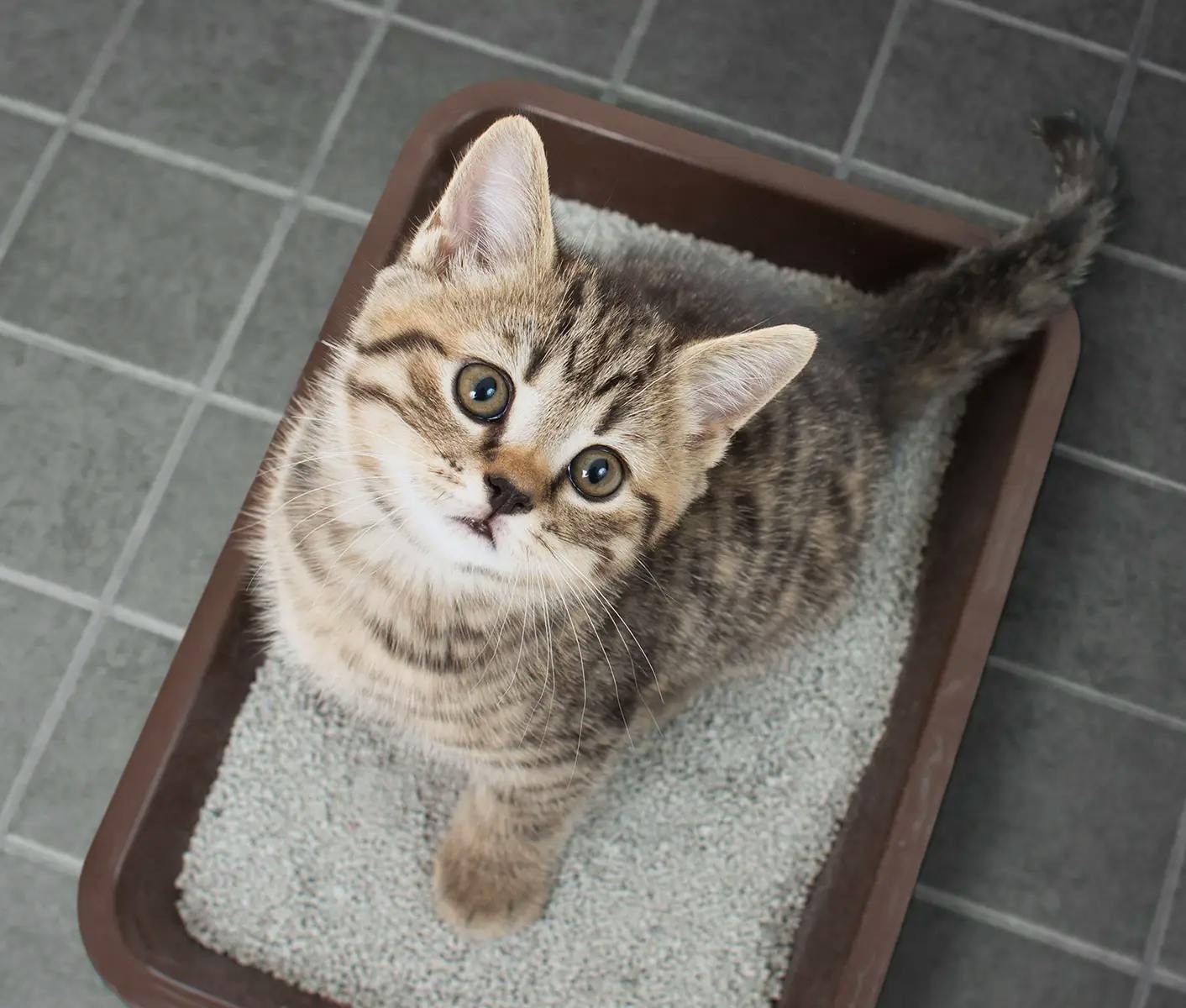Why doesn’t my cat use the litter box? When a cat that previously used the litter box reliably begins spraying or eliminating outside of it, there’s always an underlying reason. Identifying that reason, however, isn’t always straightforward. Common causes for litter box problems in cats include medical issues, litter box aversion, preference for a different surface or location, territorial marking, or separation anxiety. Pinpointing the specific cause of your cat’s house-soiling behavior is the critical first step toward resolving the issue and restoring healthy litter box habits.
Why Do Cats Not Use the Litter Box When Sick?
Before investigating behavioral reasons for litter box avoidance, schedule a veterinary exam to check for underlying health problems that could be causing your cat’s litter box issues. Identifying medical causes early is key to effective treatment.
- Causes
- Certain medical problems, such as diabetes or kidney failure, may cause cats to produce more urine than normal.
- Other medical problems, such as urinary tract infections, bladder stones, or Feline Idiopathic Cystitis (FIC) may cause a cat to feel a sense of urgency associated with urinating.
- If there is a medical problem, cats may not feel well enough or have the time to get to the litter box.
- Treatment
- A physical exam, blood tests and urinalysis from your veterinarian will determine if there is a medical issue.
- If there is a medical problem, your veterinarian will give you treatment information based on the issue.
Litter Box Aversion
If your cat has had a painful or frightening experience while in or near the box, he may move to a comfortable location with no box.
- Causes
- Multi-cat households and housemates that exert dominance can prevent one cat from entering the area where the box is placed.
- Dogs can be the trigger also – they will often chase the cat as they exit the covered box.
- A box located close to appliances or furnaces/air conditioners that make noise can be the trigger.
- Boxes located too far from the cat’s living area can be an issue for a new cat.
- Treatment
- Ease of entering and exiting the litter box is critical. Identify and move the box to an area where the cat can comfortably enter and exit the box. Cats with arthritis may struggle to get up and down stairs or in and out of the litterbox as they age.
- Locate the litter box in the cat’s typical living space – away from noisy appliances and away from feeding areas. Try moving the box to the area they are using and slowly move it to the back of the room when the cat returns to normal use.
- Remove the cover if you have one and have one more box than the number of cats you have in multi-cat households. Dominant cats sometimes guard the litter box.
Substrate Aversion or Surface Preference in Cats
Cats with substrate aversion or preference may begin by perching on the edge of the litter box and eliminating outside of it. Over time, they may fully avoid the box and choose a preferred surface based on texture or comfort.
- Causes
- Cats start aversions for a variety of reasons. Cats are very clean and a dirty box can start the behavior, as can minimal digging, scented litter, or the texture of litter.
- Some cats develop a location or surface preference. This occurs when a cat finds a room or type of surface they prefer more than his box. Typical surface preferences include soft materials – beds and carpets, laundry, or cool smooth surfaces such as sinks and bathtubs.
- Scented litters are for you – cats rarely share our love for flower smells.
- Cats that show a location preference will usually choose an area of the home that is quiet and protected or a spot where a litter box was previously kept.
- Treatment
- Studies show that cats prefer a finely textured clay litter. Return to clay litter until the problem is solved.
- Go to unscented clay litter, especially if you changed litter recently.
Cat Urine Marking Behavior
Cat urine marking or spraying is normal feline communication and not well understood, desirable, or controllable. When marking, the cat usually stands with a raised tail, which may be twitching, and he will spray a small amount of urine on vertical surfaces. Cats generally use the litter box appropriately when spraying behavior exists. Target areas often have social significance, including curtains near a window and owner suitcases.
- Causes
-
Outdoor cats near windows or doors can trigger territorial marking in indoor cats, especially near favorite resting spots.
-
Introducing a new cat to the home may lead to urine marking due to stress or dominance-related behavior.
-
- Treatment
- Spaying and neutering decreases the incidence of marking by 89 percent.
- Placing opaque film on the window to impair visual sight or installing motion detectors outside the window to move cats away could control the situation.
- Cleaning all surfaces and neutralizing urine is important. Products like Natural Touch® Urine Odor & Stain Eliminator, Equalizer Carpet Stain and Odor Eliminator, or Pureayre Odor Eliminator effectively neutralize cat urine odors at the source, helping to keep carpets fresh and clean.
- To locate hidden cat urine spots, darken the room and use a black light—dried urine will glow under UV light. Thoroughly cleaning both old and new urine stains is essential to eliminate lingering odors and prevent repeat marking behavior.
Separation Anxiety and Inappropriate Urination in Cats
Modern household routines can stress even the most adaptable cats. If your cat starts urinating on your bed, shoes, or suitcases, separation anxiety may be the cause.
- Causes
- Cats may develop anxiety if they have experienced a traumatizing event.
- Another cause of separation anxiety could be that the cat was separated from his mother too early.
- Cats may become anxious when you add a new cat into your household.
- Some cats are simply more disposed to anxiety.
- Treatment
- Use Comfort Zone® with Feliway Spray – to calm the cat’s anxiety from our schedules or from other cats.
-
Calming supplements such as Pro Plan® Veterinary Supplements Calming Care for Cats can help support cats during external stressors such as changes in routine and location.
- Catnip and catnip toys are also helpful to calm an anxious cat. Give them the toys when you leave and pick them up when you return.
- Anti-anxiety medications may be prescribed by your veterinarian to aid in calming your cat.
Addressing Litter Box Issues in Cats
Even the most well-trained cats can sometimes develop litter box avoidance or house-soiling habits. If your cat begins to eliminate outside the litter box, it’s essential to identify the root cause—whether it’s medical, behavioral, or environmental—and take appropriate steps to correct the behavior. Early intervention and the right approach can help restore proper litter box habits and ensure a clean, stress-free home for both you and your feline companion. If you have more questions or need help, call us at 800.786.4751.
LEARN MORE:
Feline Idiopathic Cystitis (FIC): Why Is My Cat Urinating Outside the Litter Box?
Learn about Feline Idiopathic Cystitis (FIC), a common but complex bladder condition in cats. Discover causes, symptoms, diagnosis, treatment, and prevention tips.
Kidney Disease in Dogs and Cats
What are the signs of kidney problems in dogs? Learn kidney disease symptoms in cats and dogs and how to test for kidney disease in dogs and cats. Discover types of kidney diseases in dogs and cats.
Feline Urinary Tract Infection
Bladder infections and crystals are common in cats. Learn about crystals and feline urinary tract infection, plus how to prevent and treat them.
Is My Cat Sick? How to Tell if Your Cat is Sick
Why is my cat acting different? Cat illness symptoms can be tricky to spot, so how can you tell if your cat is sick? Learn common sick cat symptoms that are easy to overlook.
Written by: Marty Greer, DVM
Director of Veterinary Services
Marty Greer, Doctor of Veterinary Medicine, has 40+ years’ experience in veterinary medicine, with special interests in canine reproduction and pediatrics. She received her Doctor of Veterinary Medicine from Iowa State University in 1981. She’s served as Revival’s Director of Veterinary Services since 2019. In 2023, Dr. Greer was named the Westminster Kennel Club Veterinarian of the Year.




